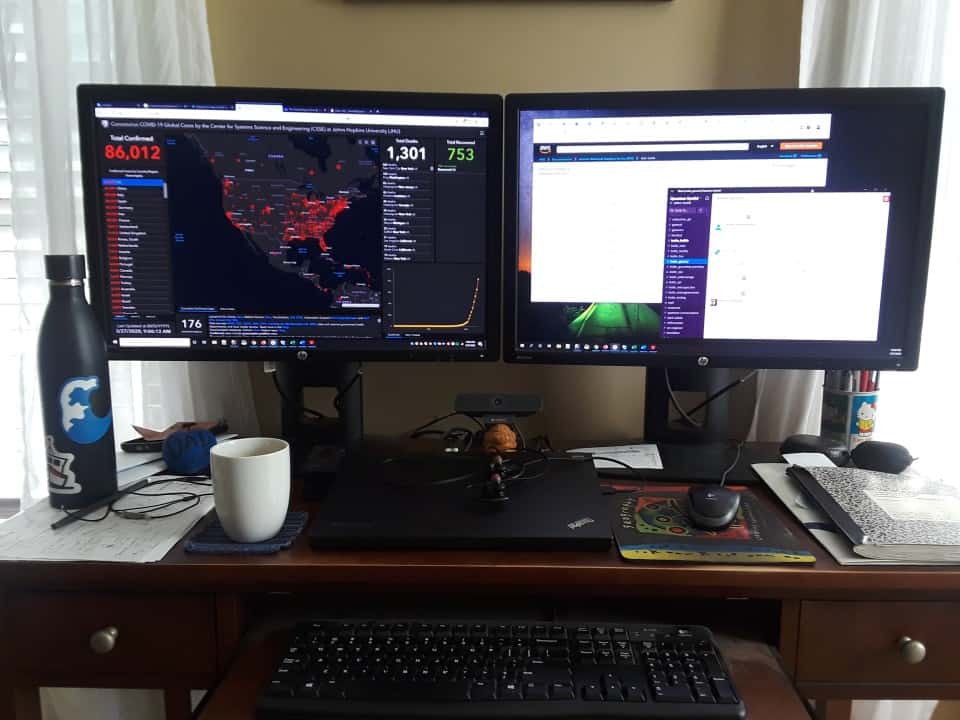Jeffrey Skahill with Quantum Spatial shares some strategies he uses to successfully lead a remote team.
I am certainly not the first person (or one-hundredth person) to share advice on working from home in response to COVID-19, but since I have been leading a fully remote team for five years, I hope some of my experiences are useful to others working remotely for the first time.
Communicate, Communicate, Communicate
You need to force communication in a remote environment. I am an introvert and so is most of my team, but you can’t let everyone go off and work in a black box. Fortunately, as software developers our team uses the agile development process, which encourages interactions. Every project we support has a daily standup where each team member provides a quick update on what they have done since yesterday, what they expect to do by tomorrow, and any blocking factors they have to complete their work. The agile methodology was designed for software development but at Quantum Spatial we use it for non-software projects too, so I encourage all remote teams to evaluate this process for their own use.
Beyond project work, all staff–not just team leaders–should set up calls to have individual conversations with other team members to check on them and maintain personal relationships while geographically dispersed. We should all be over-communicating at this time to make sure our colleagues are staying sane while trapped at home.
Use Technology with Limits
Slack is a great tool that we use for our teams, some of which extend across multiple countries. It allows us to focus and monitor conversations across multiple channels. We also make Slack fun with extra use of Giphy, sharing picks of fur babies, and entire channels dedicated to non-work discussions. One important thing to consider before introducing Slack or any other new communication tool, is don’t maintain so many tools that your team is distracted monitoring communications. I tell my team to check Slack hourly, but assume emails can be responded to within 24 hours. If there is an emergency, I call them. It is important to set expectations and boundaries for use of any communication technology or it risks slowing production or causing needless stress.

When working remotely, treat unannounced phone calls like office drop-ins and keep them at a minimum, as they force the receiver of the call to be distracted without their consent. This is particularly difficult for developers who need extended periods of time to focus. I generally send a direct message on Slack asking individuals if I can call them so the call is then timed when they have already stopped coding to check Slack.
Webcams are a great way to see your colleagues’ faces and it definitely helps for reading facial cues, but not every meeting requires cameras the entire time. I keep a busy schedule and often eat while on calls or walk around my office to stretch my legs while on calls and I don’t feel like everyone needs to see that. One of our teams recently recommended that everyone turn on cameras for the first five minutes of a call. This seems like a reasonable use of the technology.
I have yet to find a great virtual whiteboard that replaces the big whiteboard I had on my wall at my last office job, but use whatever you can (Google Docs/Sheets/Slides are great for simultaneous editing by multiple people) to document concepts and ideas in a collaborative way.
Trust
This might be the most important factor to the long-term success of a remote team. Monitor team progress, but don’t micromanage team members. I trust the people I hire to be productive and I want them to have flexibility with their schedule. This is particularly true now that remote workers with children need to make time for their families at home too. Even before the pandemic, I have a team member who says he is most productive coding very late in the night and prefers to wake up later in the morning, so we agreed that he doesn’t have any regular calls before 10AM. This has allowed him to be productive with minimal impact on anyone else on the team. Our Project Managers closely monitor task completion and time billed to their projects, so we are continually monitoring productivity and trying to work with team members to create an environment that is optimal for them to succeed.
I am interested if others can share their challenges and recommendations for leading remote teams. What works for you? What doesn’t? Weigh in with your thoughts with Jeffrey Skahill on LinkedIn.
About the author
Jeffrey Skahill is a Software Development Manager at Quantum Spatial, Inc., an NV5 company, and the nation’s largest independent geospatial data firm.
More Articles from Quantum Spatial
- How LiDAR is Being Used to Help With Natural Disaster Mapping and Management
- When Predictions Match Reality: The Power of LiDAR for Flood Warnings
- How Collecting LiDAR is Being Supported by the USGS 3D Elevation Program
